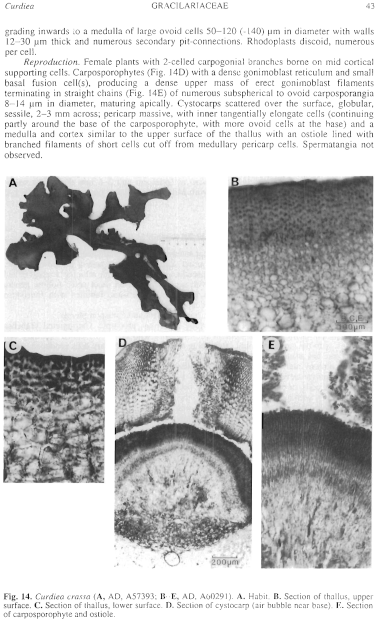|
|
|
|
|
|||||||||||
|
Electronic Flora of South Australia Species Fact Sheet
Phylum Rhodophyta – Class Florideophyceae – Order Gracilariales – Family Gracilariaceae
Selected citations: Millar & Kraft 1993: 27.
Thallus (Fig. 14A) very dark red-brown, complanate, 5–20 cm long, cartilaginous, (1–) 2–4 mm thick, decumbent with distinct upper and lower surfaces, irregularly lobed and divided with lobes 2–5 cm broad, apically rounded and usually narrower below, the underside usually covered with sponge or bryozoans. Holdfast discoid, usually at one end of the thallus, 0.5–2 cm across, thallus flat immediately above; epilithic. Structure multiaxial, pseudoparenchymatous throughout, with the cortex on the lower surface (Fig. 14B) 2–3 cells thick, outer cells 10–12 µm in diameter and L/D 1–1.5, and on the upper surface 4–15 (–20) cells thick (Fig. 14C) with anticlinal chains, outer cells 5–10 µm in diameter and L/D 1–2, grading inwards to a medulla of large ovoid cells 50–120 (–140) µm in diameter with walls 12–30 µm thick and numerous secondary pit-connections. Rhodoplasts discoid, numerous per cell.
Reproduction: Female plants with 2-celled carpogonial branches borne on mid cortical supporting cells. Carposporophytes (Fig. 14D) with a dense gonimoblast reticulum and small basal fusion cell(s), producing a dense upper mass of erect gonimoblast filaments terminating in straight chains (Fig. 14E) of numerous subspherical to ovoid carposporangia 8–14 µm in diameter, maturing apically. Cystocarps scattered over the surface, globular, sessile, 2–3 mm across; pericarp massive, with inner tangentially elongate cells (continuing partly around the base of the carposporophyte, with more ovoid cells at the base) and a medulla and cortex similar to the upper surface of the thallus with an ostiole lined with branched filaments of short cells cut off from medullary pericarp cells. Spermatangia not observed.
Tetrasporangia not observed.
Type from Muttonbird I., Coffs Harbour, N.S.W. (Millar & Chidgey, 15.vii.1981); holotype in MELU, AM563.
Selected specimens: Glaneuse Reef, Point Lonsdale, Vic., 2–3 m deep (Kraft 5789, Lewis & O'Brien, 19.ii.1976; MELU, 23244). Queenscliff, Vic., 8 m deep (Ramm & Rankin, 5.ix.1976; MELU). Cape Woolamai, Vic., 15–18 m deep S side (Goldsworthy & Berthold, 16.ii.1990; AD, A60187). Gabo I., Vic., 2–5 m deep (Shepherd, 16.ii.1973; AD, A43370). Eddystone Point, Tas., 30 m deep (Riddle, 24.ii.1990; AD, A60406). S of Eddystone Rock, Tas., 25 m deep (AIMS-NCI, Q66C 3670-G, 24.ii.1990; AD, A60291). Waterfall Bay, Tasman Pen., Tas., 13–19 m deep (McGeary-Brown, 29.x.1986; AD, A57393). Bicheno, Tas., 20–22 m deep (Kraft 9379a, 18.xii.1993; MELU, 42054).
Distribution: Known from Split Solitary I. to Jervis Bay, N.S.W. and Point Lonsdale to Gabo I., Vic., and E Tasmania.
Taxonomic notes: Millar (1990, p. 341) records C. crassa as iridescent and 2–6 mm thick. The south-eastern Australian specimens agree well with Millar's description but are usually only 1–3 mm thick.
References:
MILLAR, A.J.K. & KRAFT, G.T. (1993). Catalogue of Marine and Freshwater Red Algae (Rhodophyta) of New South Wales, including Lord Howe Island, South-western Pacific. Aust. Syst. Bot. 6, 1–90.
MILLAR, A.J.K. (1990). Marine Red Algae of the Coffs Harbour Region, northern New South Wales. Aust. Syst. Bot. 3, 293–593.
The Marine Benthic Flora of Southern Australia Part IIIB complete list of references.
Publication:
Womersley, H.B.S. (28 June, 1996)
The Marine Benthic Flora of Southern Australia
Rhodophyta. Part IIIB. Gracilarialse, Rhodymeniales, Corallinales and Bonnemaisoniales
Reproduced with permission from The Marine Benthic Flora of Southern Australia Part IIIB 1996, by H.B.S. Womersley. Australian Biological Resources Study, Canberra. Copyright Commonwealth of Australia.
Illustration in Womersley Part IIIA, 1996: FIG. 14.

Figure 14 enlarge
Fig. 14. Curdiea crassa (A, AD, A57393; B–E, AD, A60291). A. Habit. B. Section of thallus, upper surface. C. Section of thallus, lower surface. D. Section of cystocarp (air bubble near base). E. Section of carposporophyte and ostiole.

|
Email Contact: State Herbarium of South Australia |

|